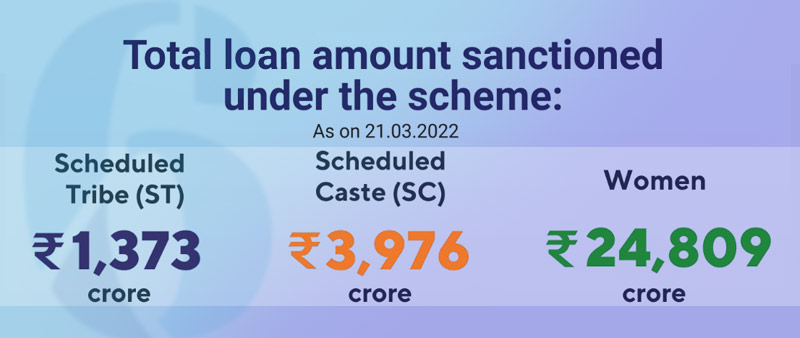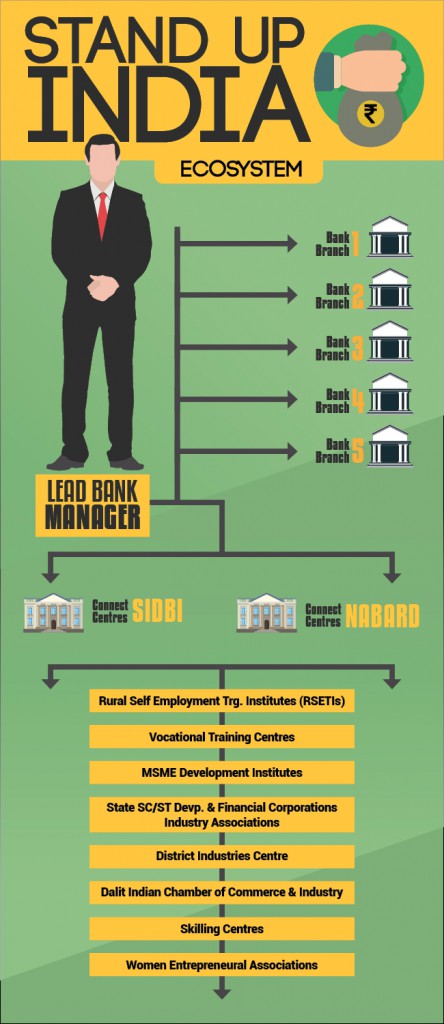STANDUP INDIA SCHEME FOR THE UPLIFTMENT OF WOMEN AND BACKWARD CLASSES
WHY IN THE NEWS?
- Stand-Up India Programme which began on April 5, 2016, is already six years old.
- The scheme was designed to support SC/ST/Women entrepreneurship to foster economic development and job creation.
- The scheme mainly focuses on Scheduled Castes (SC), Scheduled Tribes (ST) and women entrepreneurs.
BACKGROUNDER
- Since the scheme commenced, Women have accounted for more than 81% of all the Stand-up India beneficiaries with loans totalling Rs.30,160 crore sanctioned to 1,33,995 accounts.
- The scheme has been extended till the year 2025.

WHAT IS THE NEED FOR THIS SCHEME?
- The scheme intends to foster entrepreneurship among women, SC and ST, who face substantial challenges due to a lack of advice and mentorship.
- It also helps them with sufficient and timely credits in establishing their businesses.
- The scheme aims to develop a financial ecosystem that supports and continues to provide a favourable business environment.
- It aims to help prospective SC, ST and women entrepreneurs realise their dreams by boosting their energy and excitement by removing various roadblocks in their way.
- The Scheduled Commercial Banks (SCBs) provide loans under the scheme based on commercial considerations, board-approved policies and current RBI guidelines.
WHO IS ELIGIBLE FOR THE LOAN?
- SC/ST and/or female entrepreneurs over the age of 18.
- Only Greenfield projectsare eligible for the scheme's loans.
- Greenfield refers to the beneficiary’s first business in manufacturing, services or trading as well as operations related to agriculture.
- In the event of non-individual firms, SC/ST and/or women entrepreneurs shall own 51% of the shareholding and controlling stake.
- Borrowers should never default on a loan with a bank or financial organisation.
HOW IS THE SCHEME IMPLEMENTED?
- Potential borrowers are supposed to submit online applications using the standupmitra.in.portal.
- Hand-Holding assistance is available.
- A large-scale public relations campaignhas been launched.
- Form for applying for a loan that has been
- Scheme of Credit Guarantee
- Wherever possible, convergence with state and federal government plans.

WHY WERE SC/STS OVERLOOKED?
There are three plausible explanations for the SC/STs exclusion from the Stand Up India programme.
- To begin with, the SC/STs are unaware of the scheme.
- To say that the SC/ST young are unaware of the initiative is to imply that, in this age of overabundance of information, Modi's Independence Day address did not reach nearly 25% of India's population, which contradicts the logic.
- It is difficult to imagine that despite the present government’s best efforts the message is not reaching the target groups.
- Second, is the hesitance in submitting the loan applications.
- Though the loan is long-term the SC/ST and women are hesitant to submit as they are unable to meet certain criteria.
- Failure of Banks to provide required hand-holding and support to SC/ST to ensure the scheme taste success among the target classes.
- Third, they are being denied loans by bank branches.
- According to India's employment statistics, unemployment among SC/ST youth is widespread, and if given the chance, they will almost likely pursue entrepreneurship and seek bank loans.
- The present government’s promises of financial inclusion of the oppressed and disadvantaged sectors are called into question by the exclusion of SCs and STs who make up 16.2% and 8.2% of the country’s population respectively.
WHAT ARE THE BENEFITS OF THE STAND UP INDIA SCHEME?
- The initiative's main goal is to inspire and motivate new entrepreneurs to reduce unemployment.
- It provides us with professional counsel time and legal understanding.
- It will help us get started without any hiccups and help us launch.
- The long term repayment period reduces the burden of repayment for the borrowers.
- This programme will also assist entrepreneurs in removing legal, operational and other institutional barriers.
- It has the potential to be a huge help in terms of job generation and socio-economic development for Dalits, Tribals and women.
- It could also catalyze other government initiatives such as ‘Skill India’ and ‘Make In India’.
- It will aid in the preservation of India's demographic dividend.
- With access to bank accounts and technology knowledge, these people will be able to achieve financial and social inclusion.
WHAT ARE THE CHALLENGES?
- Socioeconomic aspects of Dalit business and women’s entrepreneurship have received very little attention and this initiative may not be very effective if this is not done.
- Proving the company’s standards and innovation to DIPP can pose a challenge causing a delay in funds.
- Very few women-led and SC/ST businesses meet the condition of turnover of 25 crores.
- Self-help groups that have aided women-entrepreneurs, in the past, particularly in the rural regions have fallen victim to elite institutions and have been obliterated by locally powerful interests.
- Furthermore, the banking sector has yet to make a significant impact in the hinterlands to support more inclusions.
- Consequently, despite the success of the Pradhan Mantri Jan Dhan Yojana, hurdles such as lack of institutional bank linkages, public awareness, the digital divide and a slew of other technical issues can impact bank account linkages.
- In terms of technological knowhow, access to skilled labour, industry knowledge, and so on, SC/STs and women have not been fully and truly empowered.
WHAT IS THE WAY FORWARD?
- Experts believe that the government can give an institutional framework and support services to women who want to start a business in the manufacturing sector through this scheme.
- The SC/ST community must be educated and empowered to reap the full benefits of the scheme.
- If implemented with proper ecosystem support the scheme has the potential to revolutionise the socioeconomic architecture of rural and urban India realising Gandhi’s directorial principle of fostering village and cottage enterprises.
CONCLUSION
At this point, we may conclude that the Stand-Up India Programme has failed to achieve its primary goal of empowering SC/St youth. It would have been preferable to divide the strategy into two or three stages, with a group-specific set for the bank executives. The Modi government may even consider praising and rewarding bankers who help make this scheme more inclusive while chastising those who fall short of the aim. After all, it’s all about the intent.
Social inclusion in government programmes in India only works when a quota or target is set.
It just cannot be left to the structure's and democracy's "good intentions" and "benevolence."
Sources:
https://theprint.in/opinion/modi-govts-stand-up-india-scheme-worked-for-women-but-missed-its-target-scs-sts/907669/
https://newsonair.com/2022/04/05/stand-up-india-scheme-completes-6-years-loans-over-%E2%82%B930160-cr-sanctioned-to-over-133995-accounts/
https://www.tribuneindia.com/news/nation/india-full-of-entrepreneurial-energy-stand-up-india-part-of-efforts-to-further-progress-pm-383850
https://www.thehindu.com/news/national/andhra-pradesh/officials-told-to-give-wide-publicity-to-stand-up-india-scheme/article65240439.ece
NEWS IN BRIEF: PRELIMS SPECIAL
Solid Fuel Ducted Ramjet
- Defence Research and Development Organisation, DRDO successfully flight tested the Solid Fuel Ducted Ramjet (SFDR) booster at the Integrated Test Range, Chandipur off the coast of Odisha.
- The test successfully demonstrated the reliable functioning of all critical components involved in the complex missile system and met all the mission objectives.
- The SFDR-based propulsion enables the missile to intercept aerial threats at very long range at supersonic speeds.
- The SFDR has been developed by Defence Research and Development Laboratory, Hyderabad in collaboration with other DRDO laboratories such as Research Centre Imarat, Hyderabad and High Energy Materials Research Laboratory, Pune
- The SFDR technology is a missile propulsion system based on the principle of the Ramjet Engine.
- A solid-fuel air-breathing ramjet engine powers the apparatus.
- The Ramjet, unlike solid propellant rockets, absorbs oxygen from the atmosphere while in flight.
- As a result, it is light and can carry more gasoline.
https://newsonair.gov.in/News?title=DRDO-conducts-successful-flight-test-of-Solid-Fuel-Ducted-Ramjet&id=438792
Mudra Yojana
- Prime Minister Narendra Modi has said that Mudra Yojana has allowed countless Indians to showcase their entrepreneurial skills and become job creators.
- The scheme has become a game-changer and enhanced dignity as well as prosperity.
- The government is promoting entrepreneurship at grassroots levels, focusing on economic empowerment and job creation.
- The schemes provide easy access to credit to small and micro-entrepreneurs.
- It was established by the government in 2015 to provide non-corporate, non-farm small/micro-enterprises with loans of up to Rs. 10 lakh.
- MUDRA does not make direct loans to micro-businessesor individuals.
- According to the stage of growth and finance demands of the beneficiary micro unit, MUDRA has developed three products: 'Shishu,' 'Kishore,' and 'Tarun.'
- Shishu:covering loans up to 50,000
- Kishore:Covering loans above 50,000 and up to Rs. 5 lakh.
- Tarun:covering loans above 5 lakh and up to Rs. 10 lakh.
- This strategy allows for no-collateral lending.
https://newsonair.gov.in/News?title=Mudra-Yojana-gives-opportunity-to-Indians-to-showcase-entrepreneurial-skills-and-become-job-creators%3a-PM-Modi&id=438786
Army Ordnance Corps
- Army Ordnance Corps celebrated its 247th raising day.
- The Corps came into existence with the establishment of the ‘Board of Ordnance’ on 8th April 1775.
- The Corps is entrusted with the onerous task of managing a large and complex inventory and providing logistic support to the Army.
- The Board of Ordnance underwent a variety of changes over the years, eventually becoming the Indian Army Ordnance Corps in 1922.
- The prefix 'Indian' was eliminated after India became a Republic in 1950, and the organisation has been known as the Army Ordnance Corps ever since.
https://newsonair.gov.in/News?title=Army-Ordnance-Corps-celebrates-its-247th-raising-day-today&id=438765
World Health Day
- The Union Health Ministry has said that India has registered a significant decline in the maternal and infant mortality rate and it will achieve the target of Sustainable Development Goals before the deadline of 2030.
- It is celebrated on April 7th to commemorate the World Health Organization's founding in 1948.
- On this day, WHO will focus on the urgent actions that must be taken to keep humans and the earth healthy around the world, as well as nurture a movement to establish a society centred on well-being.
- As defined by the World Health Organization (WHO),Health is a "State of complete physical, mental, and social well-being and not merely the absence of disease or infirmity."
- "Our Planet, Our Health" is the theme for World Health Day 2022.
- This year's topic is "Keeping Humans and the Planet Healthy," as well as "Fostering a Movement to Create a Well-Being Society."
https://newsonair.gov.in/News?title=World-Health-Day%3a-India-will-achieve-the-target-of-Sustainable-Development-Goals-before-the-deadline-of-2030%2c-says-Govt&id=438702





